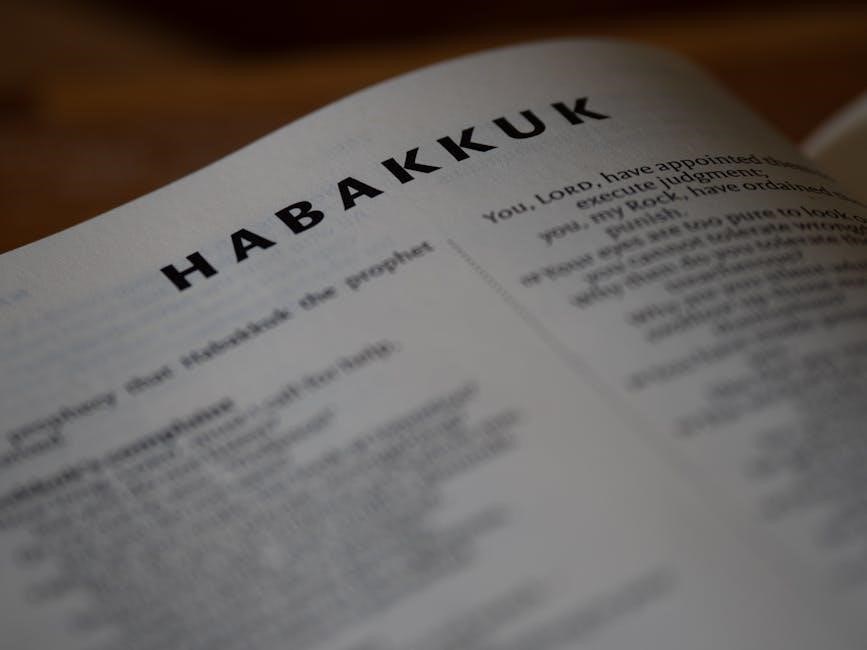A Bible Prophets Timeline Chart is a visual tool that organizes the ministries of prophets chronologically, providing historical context and clarity to their prophecies and messages.
It connects Old Testament prophets like Isaiah and Ezekiel with New Testament figures such as John the Baptist, offering a comprehensive view of divine communication across centuries.
Available as a PDF, this chart simplifies studying the prophets’ roles, making it invaluable for personal Bible study, teaching, and understanding God’s plan throughout history.
Overview of the Importance of Prophets in the Bible
The prophets in the Bible served as messengers of God, delivering divine messages to guide His people. Their role was crucial in shaping Israel’s history, calling people to repentance, and foretelling future events. Prophets emphasized justice, morality, and faith, providing spiritual direction during times of crisis. Their teachings laid the foundation for Christianity, offering hope through promises of redemption and the coming Messiah. Understanding their ministries is essential for grasping the biblical narrative and God’s plan for humanity. A timeline chart helps visualize their contributions, making their collective impact clearer and more accessible for study and reflection.
Why a Timeline Chart is Essential for Understanding Prophets
A Bible prophets timeline chart is indispensable for grasping the chronological sequence of prophetic ministries, providing clarity to their messages and historical contexts.
It visually organizes the prophets’ roles, making it easier to understand how their prophecies align with biblical events and God’s overarching plan.
By mapping the timeline, readers can trace the progression of divine revelation, identify key events, and appreciate how prophets like Isaiah, Jeremiah, and Ezekiel fit into the broader narrative.
This tool is particularly useful for Bible study, as it helps learners connect prophetic writings with historical periods, enhancing comprehension and deepening spiritual insight.

Major Prophets in the Old Testament
The major prophets, including Isaiah, Jeremiah, Ezekiel, and Daniel, played pivotal roles in shaping Israel’s history through their profound prophecies and divine messages during critical periods.
Isaiah: His Prophecies and Historical Context
Isaiah, one of the most prominent Old Testament prophets, ministered during the 8th century BC, spanning the reigns of King Uzziah to King Hezekiah. His prophecies, recorded in the Book of Isaiah, address both judgment and redemption, emphasizing God’s holiness and justice. Isaiah’s famous prophecy of the Messiah (Isaiah 53) is a cornerstone of Christian theology. His ministry occurred during a time of political turmoil, with Assyria threatening Judah, providing a rich historical backdrop for his messages. The Bible Prophets Timeline Chart PDF highlights his role and timeline, helping readers understand his contributions within the broader narrative of God’s plan.
Jeremiah: The Prophet of Judgment and Hope

Jeremiah, often called the “weeping prophet,” ministered during a tumultuous period, witnessing the fall of Jerusalem and the exile of Judah. His prophecies emphasized judgment for Israel’s sins but also offered hope for future restoration. Called by God as a youth, Jeremiah faced intense opposition yet remained faithful, delivering messages of repentance and divine mercy. His ministry spanned over 40 years, overlapping with the reign of King Josiah and the eventual destruction of the Temple. Jeremiah’s emotional struggles and deep compassion for his people are evident in his writings, including the Book of Lamentations.
- His prophecies highlighted the consequences of disobedience.
- Jeremiah’s message balanced judgment with the promise of hope.
- His ministry bridged the pre-exilic and exilic periods.
Ezekiel: Visions and Ministry During Exile
Ezekiel, a priest-turned-prophet, ministered during the Babylonian exile, delivering messages of judgment and hope. His visions, including the valley of dry bones, symbolized Israel’s spiritual death and future restoration. Ezekiel’s ministry began in 593 B.C., five years after his exile to Babylon. His prophecies often involved dramatic symbolic actions, such as lying on his side for 390 days, to convey God’s message. Despite the harshness of his warnings, Ezekiel’s ministry emphasized God’s mercy and the promise of a renewed covenant with His people.
- Ezekiel’s call included a divine vision of God’s glory;
- His prophecies addressed both the exiles and those remaining in Jerusalem.
- His ministry highlighted the importance of individual accountability before God.
Daniel: Prophecies and Apocalyptic Visions
Daniel, a prophet and statesman, served in Babylon during the 6th century B.C. (604-535 B.C.). His prophecies included apocalyptic visions of future empires and the Messiah’s coming. Daniel’s ministry began with interpreting Nebuchadnezzar’s dreams, revealing God’s sovereignty over nations. His visions of the four beasts and the 70 weeks provided a timeline for Israel’s redemption. Daniel’s prophecies emphasized faith in God’s ultimate triumph and encouraged believers to remain faithful during persecution. His writings are foundational for understanding end-time events and God’s plan for humanity.
- Daniel’s visions foresaw the rise and fall of world empires.
- His prophecy of the Messiah’s arrival was fulfilled in Jesus Christ.
- Daniel’s faith and integrity inspired trust in God’s plan.

Minor Prophets in the Old Testament
The Minor Prophets, despite their name, hold significant importance in the Bible, addressing themes of justice, repentance, and restoration. Their collective writings span 12 books.
A timeline chart highlights their ministries, emphasizing their unique roles in Israel’s history and God’s plan. Prophets like Hosea, Joel, and Amos called for social justice.
- Hosea emphasized God’s love and judgment.
- Joel foretold the Day of the Lord.
- Amos stressed moral accountability.
Hosea: The Prophet of Love and Judgment
Hosea, an 8th-century prophet, ministered to Israel during a time of spiritual decay and political turmoil. His prophecies, spanning 750–725 BC, emphasized God’s love and impending judgment. Hosea’s unique ministry included marrying Gomer, a woman symbolizing Israel’s unfaithfulness, to illustrate God’s steadfast love despite rebellion. His messages balanced judgment with redemption, urging Israel to return to the Lord. Hosea’s prophecies are foundational in understanding God’s heart for His people, blending stern warnings with promises of restoration. His ministry is a powerful example of divine patience and the call to repentance, resonating throughout the Bible.
Joel: The Day of the Lord and Restoration
Joel, a minor prophet, emphasized the Day of the Lord, a time of judgment and restoration. His prophecy called Israel to repentance, urging them to turn back to God.
Joel’s message highlighted the devastation of a locust invasion as a metaphor for God’s judgment, stressing the need for spiritual renewal and sincerity in worship.
He also offered hope, promising the outpouring of God’s Spirit on all people, as stated in Joel 2:28-29, a verse later quoted in Acts 2 during Pentecost.
Joel’s focus on social justice and the restoration of Israel makes his prophecy a bridge between judgment and redemption, fitting seamlessly into a Bible Prophets Timeline Chart.
Amos: Social Justice and Divine Judgment
Amos, a minor prophet, emphasized social justice and divine judgment, ministering around 750 BC. His prophecies targeted Israel’s corruption and oppression of the poor.
As a shepherd, Amos delivered God’s message, condemning injustice and calling for repentance. His famous phrase, “Let justice roll down like rivers,” highlights his focus on ethical living.
Amos prophesied the fall of Samaria and Israel’s exile, warning of God’s judgment for their disobedience. His teachings remain relevant, urging believers to prioritize justice and righteousness in society.
Obadiah: The Shortest but Powerful Prophecy
Obadiah, the shortest book in the Old Testament, delivers a powerful message of judgment and hope. His prophecy focuses on the fall of Edom, a neighboring nation to Israel, for its pride and betrayal of God’s people. Obadiah emphasizes the Day of the Lord, a time of divine reckoning and restoration for Israel. Despite its brevity, Obadiah’s prophecy carries significant weight, offering insights into God’s justice and mercy. Its placement in the Bible Prophets Timeline Chart highlights its historical context and role in the broader narrative of redemption and divine judgment.
Jonah: The Reluctant Prophet and His Mission
Jonah, a prophet from Gath Hepher, is renowned for his reluctance to obey God’s call to preach to Nineveh. Initially, he fled by sea, leading to a miraculous encounter with a great fish that swallowed him. After three days, Jonah was released and fulfilled his mission, urging the people of Nineveh to repent. His message was met with widespread response, as the entire city turned to God, showcasing divine mercy. Jonah’s story, often highlighted in Bible timeline charts, illustrates God’s patience and the power of obedience, making it a pivotal moment in prophetic history.
Micah: The Prophet of Justice and Messiah
Micah, a minor prophet, ministered during the 8th century BC, addressing both Judah and Israel. He emphasized justice, condemning oppression and corruption, urging repentance and faithfulness to God. Micah’s prophecies include the famous foretelling of the Messiah’s birth in Bethlehem, highlighting God’s redemptive plan. His messages blend judgment with hope, calling for moral integrity and trust in God. Micah’s ministry aligns with the broader prophetic timeline, offering insights into the social and spiritual challenges of his era. His teachings remain central to understanding the biblical narrative of justice and redemption, as reflected in various Bible prophets timeline charts.
Nahum: The Fall of Nineveh
Nahum, a minor prophet, prophesied around 660–612 BC, focusing on the impending fall of Nineveh, the Assyrian capital. His prophecy emphasized God’s judgment on Assyria for its cruelty and idolatry.
Nahum’s book consists of three chapters, vividly describing Nineveh’s destruction and the restoration of Israel. His imagery of war, natural disasters, and divine wrath underscores the inevitability of Assyria’s downfall.
Nahum’s prophecy was fulfilled in 612 BC when Nineveh was conquered by the Babylonians and Medes. His message highlights God’s justice and mercy, serving as a warning to nations and a comfort to Israel.
Habakkuk: Faith and Doubt in God’s Plan

Habakkuk, a minor prophet, ministered around 600 BC, just before the fall of Jerusalem to the Babylonians. His prophecy is unique, as it records a dialogue with God, expressing deep doubts about divine justice. Despite his questions, Habakkuk ultimately affirms trust in God’s plan, emphasizing faith and patience. His message highlights the tension between human understanding and God’s sovereignty, offering a powerful lesson in perseverance. A Bible prophets timeline chart places Habakkuk’s ministry in context, showing his role in preparing Israel for exile and the eventual hope of restoration.
Zephaniah: The Day of the Lord’s Wrath
Zephaniah prophesied during King Josiah’s reign (640–620 BC), emphasizing the imminent Day of the Lord, a time of divine judgment and wrath.
His prophecies targeted Judah and neighboring nations, condemning their idolatry and moral corruption, urging repentance to avoid destruction.
Zephaniah’s message highlighted God’s universal judgment, with a call to seek refuge in the Lord, offering hope for restoration after repentance.
His ancestry is traced to King Hezekiah, adding credibility to his prophetic role.
Zephaniah’s prophecies are included in Bible timeline charts, providing a chronological context for his ministry and message.
Haggai: Rebuilding the Temple
Haggai, a post-exilic prophet, played a crucial role in encouraging the Israelites to rebuild the Temple after their return from Babylonian exile.
His prophecies, delivered around 520 B;C., emphasized the importance of prioritizing God’s house over personal interests, urging the people to resume construction.
Haggai’s messages were direct and motivational, promising God’s presence and blessings upon their obedience, which ultimately led to the completion of the Second Temple.
His ministry marked a significant turning point in Israel’s spiritual renewal, highlighting the connection between faith, action, and divine favor.

Zechariah: Visions of Restoration
Zechariah, a post-exilic prophet, ministered during the rebuilding of Jerusalem after the Babylonian exile, around 520–518 BC. His prophecies focused on Israel’s restoration and spiritual renewal.
Zechariah’s visions, recorded in his book, emphasized God’s judgment on sin and His promise to restore Jerusalem. He called the people to repentance and faith, urging them to trust in God’s plan.
His messianic visions, such as the coming King and the “Branch,” pointed to a future savior. Zechariah’s ministry bridged the gap between the Old Testament prophets and the New Testament era.
His prophecies remain central to understanding God’s redemptive plan, making his visions a key part of any Bible prophets timeline chart.
Malachi: The Final Prophet and Call to Repentance
Malachi, the last prophet of the Old Testament, ministered around 450–400 BC, a time of spiritual decline after the Babylonian exile. His prophecies focused on calling Israel to repentance and faithfulness to God.
Malachi condemned practices like corrupt sacrifices, divorce, and withholding tithes, urging the people to return to covenant obedience. His prophecies also looked forward to the coming Messiah and the “day of the Lord.”
Malachi’s ministry marked the close of the Old Testament prophetic era, bridging the gap until the arrival of John the Baptist. His messages are vital for understanding God’s plan and are often included in Bible prophets timeline charts for their historical and theological significance.

New Testament Prophets
The New Testament introduces prophets like John the Baptist and Jesus Christ, who served as bridges between the Old and New Testaments, emphasizing repentance and divine fulfillment.
John the Baptist: The Bridge Between Testaments
John the Baptist serves as a pivotal figure, bridging the Old and New Testaments. His ministry marked the transition from prophetic anticipation to the arrival of Jesus Christ.
Known for baptizing Jesus in the Jordan River, John’s message of repentance and preparation for the Messiah fulfilled Old Testament prophecies. His role emphasized moral renewal and spiritual readiness.
As a prophet, John faced martyrdom for his unwavering commitment to truth. His legacy underscores the continuity of God’s plan, making him a cornerstone in Bible timeline charts and studies.

Jesus Christ: The Ultimate Prophet
Jesus Christ is often regarded as the ultimate prophet, fulfilling Old Testament prophecies and embodying God’s message to humanity. His ministry marked the culmination of prophetic revelation, bridging the Old and New Testaments. Unlike earlier prophets, Jesus’ teachings emphasized love, forgiveness, and salvation, ultimately sacrificing Himself to redeem humanity. A Bible Prophets Timeline Chart highlights His unique role, showing how His life and teachings align with prophetic expectations. This visual tool underscores Jesus’ divine authority and the fulfillment of messianic prophecies, making Him the central figure in biblical prophecy and the cornerstone of Christian faith.
Creating a Bible Prophets Timeline Chart
Developing a timeline chart involves listing prophets chronologically, noting their ministries, key prophecies, and historical contexts, ensuring clarity and accuracy for effective Bible study.
Include both major and minor prophets, marking their active periods and aligning them with biblical events to visualize God’s plan and prophetic fulfillments over time.
A PDF format allows easy sharing and printing, making it a practical tool for personal or group Bible studies to enhance understanding of prophetic messages and their significance.
Steps to Develop a Comprehensive Timeline
To create a detailed Bible Prophets Timeline Chart, start by researching historical data on prophets, their active periods, and key events mentioned in the Bible and extrabiblical sources.
List prophets chronologically, noting their ministries’ start and end dates, and align them with historical events like the division of Israel or the Babylonian exile.
Include major kings of Israel and Judah, as their reigns often overlap with prophetic ministries, providing context for the prophets’ messages.
Highlight significant prophecies, such as Ezekiel’s visions or Daniel’s apocalyptic revelations, and mark their fulfillment where applicable.
Use visual elements like color coding to differentiate between major and minor prophets or to indicate periods of exile or restoration.
Verify dates for accuracy, using scholarly resources to resolve discrepancies in timelines.
Finally, organize the information into a clear, visually appealing chart, ensuring it is easy to follow and suitable for printing or digital use.
Downloadable PDF versions of such charts are widely available online, offering a convenient starting point for further customization.
Design Tips for an Effective Visual Representation
A well-designed Bible Prophets Timeline Chart should prioritize clarity and readability. Use a clean layout with a clear timeline line, marking key dates and events chronologically.
Employ color coding to differentiate between major and minor prophets, or to highlight periods of exile, restoration, or specific kingdoms (e.g., Israel vs. Judah).
Incorporate icons or symbols to represent significant events, such as the destruction of Jerusalem or the rebuilding of the Temple.
Add parallel historical context, like the reigns of kings or major empires, to provide a broader perspective.
Include a legend or key to explain symbols and colors, ensuring the chart is easy to interpret.
Keep the design scalable for both print and digital formats, ensuring readability at various sizes.
Use high-resolution images and fonts for clarity, especially in PDF versions.
Avoid clutter by grouping related information and using white space effectively.
Ensure the timeline is visually appealing while maintaining accuracy and educational value.
Key Events to Include in the Timeline
Include major historical events like the division of Israel into two kingdoms (931 BC), the fall of Jerusalem (586 BC), and the Babylonian exile.
Highlight prophetic ministries, such as Isaiah’s predictions of Messiah, Jeremiah’s call to repentance, and Ezekiel’s visions during exile.
Add the destruction of the Temple, the return from exile under Cyrus, and the rebuilding of the Temple during the Persian era.
Mark the transition from Old Testament prophets to New Testament figures like John the Baptist and Jesus Christ.
Include significant battles, reigns of key kings, and the rise and fall of empires (e.g., Assyria, Babylon, Persia).
Highlight restoration themes, such as Haggai and Zechariah’s calls to rebuild the Temple and spiritual renewal.
Ensure clarity by separating events into BC and AD timelines, with clear labels for each period.
Use bullet points or symbols to denote prophetic activity alongside historical events for easy reference.

Sources for Bible Prophets Timeline Charts
Free Bible Timeline Printables and PDF resources are available online, offering detailed charts of prophets and kings from trusted sources like Bible Charts and Maps.
Official Bible Charts and Maps
Official Bible charts and maps are reliable resources for understanding the timeline of prophets. These charts, often available as PDFs, provide detailed overviews of prophetic ministries, historical events, and their chronological order.
Resources like Barnes Bible Charts and the Scofield Study System offer comprehensive visuals, including timelines for prophets such as Daniel (604–535 B.C.) and Ezekiel (593 B.C.).
These charts often include color-coded sections for Israel and Judah, highlighting their divided kingdoms and the prophets’ roles during these periods. They are invaluable for studying the historical context of prophetic messages and their relevance to God’s plan.
Free PDF Resources Available Online
Free Bible Prophets Timeline Chart PDF resources are widely available online, offering detailed visual representations of prophetic ministries and events. Websites like the Word Of God Team provide downloadable charts that outline the chronological order of prophets, their historical contexts, and key prophecies. These resources often include maps, timelines, and comparative analyses to enhance understanding. Many charts, such as those from Barnes Bible Charts, focus on the exilic period, highlighting prophets like Daniel and Ezekiel. Others, like the Old Testament Prophets Timeline by Jessica Lee, offer color-coded visuals for clarity. These free PDFs are ideal for personal study, teaching, or integrating into Bible lessons, making them invaluable tools for deeper spiritual insight and education.
Recommended Websites for Download
Several websites offer high-quality Bible Prophets Timeline Chart PDF downloads for free. The Word Of God Team provides detailed charts with historical context and prophetic messages. Barnes Bible Charts offers comprehensive timelines, including exilic prophets like Daniel and Ezekiel. Additionally, resources from Bethel Leadership Institute and Bible Charts and Maps, LLC are highly recommended for their accuracy and visual clarity. These websites cater to both personal study and educational purposes, ensuring a deeper understanding of biblical prophecy and its historical significance. They are reliable sources for downloading well-structured and informative timeline charts.

Using the Timeline Chart for Study
A Bible Prophets Timeline Chart helps organize prophetic ministries chronologically, aiding in understanding their roles and messages within historical contexts.
Free PDF resources and Bible study printables enable easy integration into lessons, enhancing engagement and visual learning for deeper spiritual insight;
By visualizing the timeline, students can trace prophetic fulfillments and connect prophecies to historical events, enriching their study of Scripture and its divine plan.
How to Interpret the Timeline for Deeper Understanding
Interpreting a Bible Prophets Timeline Chart involves aligning prophetic ministries with historical events and kingdoms, such as Israel and Judah, to grasp their context and relevance.
- Analyze the timeline to identify how prophets like Ezekiel and Daniel ministered during exile, while others, such as Jeremiah, operated in Judah before its fall.
- Observe how prophecies intersect with key events, such as the destruction of Jerusalem or the rise of Babylon, to understand their significance.
- Study the progression of messages, from judgment to restoration, to see God’s overarching plan and the fulfillment of prophecies over time.
This approach enriches Bible study by revealing the prophets’ roles in shaping history and their relevance to spiritual growth.
Integrating the Chart into Bible Study Lessons
Using a Bible Prophets Timeline Chart in lessons enhances engagement and understanding by visually connecting prophets to historical events and biblical narratives.
- Begin by printing or displaying the chart to provide a chronological framework for discussion.
- Highlight key prophets and their ministries, linking them to specific scriptures for deeper context.
- Discuss how the timeline aligns with the rise and fall of kingdoms, such as Israel and Judah, to illustrate God’s plan.
- Encourage group interaction by asking participants to identify patterns or connections between prophecies and historical events.
This method fosters a structured and interactive learning environment, making complex biblical history accessible and memorable.
Teaching Others Using the Timeline
A Bible Prophets Timeline Chart is an effective tool for teaching, offering a clear visual guide to help others understand the sequence of prophetic ministries and their historical context.
- Begin by printing or projecting the chart to provide a visual framework for the lesson.
- Highlight key prophets like Ezekiel and Daniel, explaining their roles and how their ministries align with historical events.
- Use the chart to illustrate how prophecies intersect with the rise and fall of kingdoms, reinforcing God’s sovereignty.
- Encourage group discussion by asking participants to identify patterns or connections between prophets and their messages.
- Share digital versions of the chart for further study, ensuring learners can reference it outside the classroom.
This approach makes complex biblical history engaging and accessible for learners of all ages.
Comparative Analysis of Different Timeline Charts
Different Bible prophets timeline charts vary in design and focus, with some emphasizing minor prophets, others detailing chronological order, and certain charts using color-coded keys for clarity.
Differences in Representation Across Various Charts
Various Bible prophets timeline charts differ in their representation, with some focusing on chronological order and others emphasizing prophetic themes or historical contexts.
Some charts, like those from Word Of God Team, offer a PDF format with detailed prophetic ministries, while others, such as Barnes Bible Charts, highlight the exilic period and key prophets like Ezekiel and Daniel.
Color-coded timelines, such as the Old Testament Prophets Timeline, distinguish between Israel and Judah, while others, like the Timeline of Kings and Prophets, integrate royal reigns with prophetic activity.
These variations provide unique perspectives, making some charts more suitable for historical analysis and others for theological study, depending on the user’s focus and needs.
Which Chart is Most Accurate and Why
The most accurate Bible prophets timeline chart is one that aligns with biblical chronology and historical records, ensuring precise dates and events.
Charts like the Old Testament Prophets Timeline and Barnes Bible Charts are highly regarded for their attention to detail, integrating prophetic ministries with historical contexts such as the exilic period and the reign of kings.
Accuracy also depends on the chart’s ability to harmonize prophetic messages with their historical settings, such as Ezekiel’s visions during exile or Daniel’s apocalyptic prophecies.
Ultimately, the best chart is one that balances scholarly research with clear, organized presentation, making it a reliable tool for deeper biblical understanding;
Historical Context of Prophets
The prophets’ ministries were deeply influenced by the political and social turmoil of their times, such as the division of Israel and Judah, and the Babylonian exile.
Understanding the Political and Social Background
The political and social backdrop of the Bible prophets is crucial for interpreting their messages. The division of Israel into two kingdoms (Israel and Judah) after King Solomon’s reign created distinct political climates. Prophets like Amos and Hosea addressed social injustices in Israel, while Isaiah and Jeremiah focused on Judah’s struggles. The rise of Assyria and Babylon as regional powers shaped prophetic warnings, as seen in Ezekiel’s ministry during the Babylonian exile. Understanding these contexts helps clarify how prophets addressed specific issues, making their messages more relevant to the timeline chart’s historical framework.
How Historical Events Shaped Prophetic Messages
Historical events significantly influenced the messages of Bible prophets, as their prophecies often addressed the political and social contexts of their time. For instance, the fall of kingdoms, exile, and foreign invasions shaped their warnings and promises. Prophets like Ezekiel and Daniel ministered during the Babylonian exile, reflecting on judgment and future restoration. The division of Israel into two kingdoms (Israel and Judah) also framed their messages, with prophets addressing specific rulers and nations. These events, visualized in a Bible Prophets Timeline Chart, reveal how God’s plan unfolded through history, making the prophets’ words relevant to both their contemporaries and future generations.
A Bible Prophets Timeline Chart PDF is an invaluable resource for spiritual growth, offering a clear, organized view of prophetic ministries and their significance in God’s plan.
Final Thoughts on the Value of a Prophets Timeline Chart
A Bible Prophets Timeline Chart is an invaluable resource for understanding the chronological flow of prophetic ministries and their significance in God’s plan.
It bridges the gap between historical events and spiritual messages, offering clarity and depth to Bible study. The chart’s visual representation makes complex timelines accessible, aiding in teaching and personal reflection.
With free PDF options available, it’s convenient to download and share, ensuring widespread use for spiritual growth and educational purposes. Ultimately, this tool enriches one’s appreciation of Scripture and its prophets.
Encouragement to Use the Chart for Spiritual Growth
Using a Bible Prophets Timeline Chart can deepen your faith by revealing the interconnectedness of God’s plan across centuries. It helps visualize how prophecies unfold, offering insight into His eternal purposes.
By studying the chart, you can better understand the prophets’ roles in history, fostering a deeper appreciation for Scripture. It’s a powerful tool for personal reflection, group Bible studies, or teaching others about God’s redemptive plan.
Download a free PDF chart today and embark on a journey to enrich your spiritual growth, gaining clarity and inspiration from the prophets’ timeless messages.
